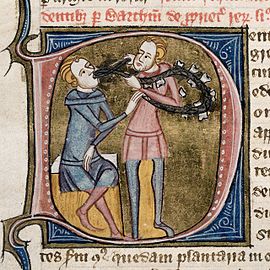
Infirmary, Rievaulx Abbey
The infirmary was where monks went when they were unable to fulfil their duties because of ill health or advanced age. It was also the place to which elderly monks retired. Infirmaries usually had their own chapel, dormitory, refectory, kitchen and latrines. Some infirmaries even had their own cloister where its inhabitants could walk. The infirmary cloister garth was probably a herb garden for the pharmacy. In many ways, it was a monastery within the monastery, but on a much smaller scale.
All the monks stayed there at some point, since they had regular blood-lettings and they were allowed to convalesce in the infirmary for three days afterwards. With its special diet (including meat) and a fire, it was much more comfortable than anywhere else in the monastery, so spending any time there must have made a very pleasant change. The main part of the infirmary space would have been partitioned with wood or stone to make cubicles containing only one or two beds, which would also have made a stay there desirable. The infirmarian and his staff had to be careful, though, as it wasn’t unknown for monks to pretend to be ill in order to enjoy the comforts of the infirmary for a few days.
Sometimes the infirmarian was a physician, but more often a lay physician was employed by the monastery to work under him. He would have been assisted by a staff of monks.
Within the infirmary, there was a pharmacy where herbal remedies were made. It would probably have had a library, probably just a chest, of medical books.
Whatever our opinion of the state of medical knowledge in the Middle Ages might be, they knew as well as we do, that rest is important for the sick. In most monasteries, the infirmary was built far away from the main cloister, where healthy monks walked, worked and taught, in order to ensure that its inhabitants could have peace and quiet.
Care of the sick was important for those following the Benedictine rule. St. Benedict wrote, “Care of the sick must rank above and before all else, so that they may truly be served as Christ, for he said: I was sick and you visited me, and What you did for one of these least brothers you did for me.” This care extended beyond the monks themselves. In Cistercian monasteries, there was a separate infirmary for the lay brothers and many monasteries provided another infirmary for lay people living nearby, either within the monastery or just outside. St. Bartholomew’s Hospital in Smithfield started in this way, like many other hospitals, in the twelfth century.
By the fifteenth century, the monastic population had decreased and large infirmaries were no longer needed. Some were converted in guest houses or lodgings for the abbot, but some were demolished so that the stone could be reused.
Sources:
The Companion to Cathedrals and Abbeys by Stephen Friar
April Munday is the author of the Soldiers of Fortune and Regency Spies series of novels, as well as standalone novels set in the fourteenth century.
Available now:









